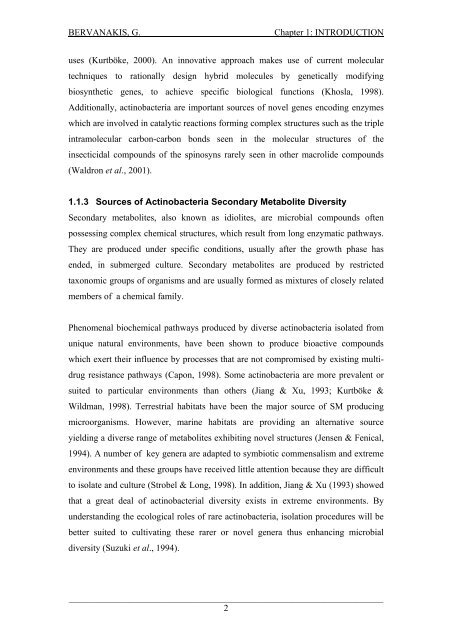Detection and Expression of Biosynthetic Genes in Actinobacteria ...
Detection and Expression of Biosynthetic Genes in Actinobacteria ...
Detection and Expression of Biosynthetic Genes in Actinobacteria ...
Create successful ePaper yourself
Turn your PDF publications into a flip-book with our unique Google optimized e-Paper software.
BERVANAKIS, G.Chapter 1: INTRODUCTIONuses (Kurtböke, 2000). An <strong>in</strong>novative approach makes use <strong>of</strong> current moleculartechniques to rationally design hybrid molecules by genetically modify<strong>in</strong>gbiosynthetic genes, to achieve specific biological functions (Khosla, 1998).Additionally, act<strong>in</strong>obacteria are important sources <strong>of</strong> novel genes encod<strong>in</strong>g enzymeswhich are <strong>in</strong>volved <strong>in</strong> catalytic reactions form<strong>in</strong>g complex structures such as the triple<strong>in</strong>tramolecular carbon-carbon bonds seen <strong>in</strong> the molecular structures <strong>of</strong> the<strong>in</strong>secticidal compounds <strong>of</strong> the sp<strong>in</strong>osyns rarely seen <strong>in</strong> other macrolide compounds(Waldron et al., 2001).1.1.3 Sources <strong>of</strong> Act<strong>in</strong>obacteria Secondary Metabolite DiversitySecondary metabolites, also known as idiolites, are microbial compounds <strong>of</strong>tenpossess<strong>in</strong>g complex chemical structures, which result from long enzymatic pathways.They are produced under specific conditions, usually after the growth phase hasended, <strong>in</strong> submerged culture. Secondary metabolites are produced by restrictedtaxonomic groups <strong>of</strong> organisms <strong>and</strong> are usually formed as mixtures <strong>of</strong> closely relatedmembers <strong>of</strong> a chemical family.Phenomenal biochemical pathways produced by diverse act<strong>in</strong>obacteria isolated fromunique natural environments, have been shown to produce bioactive compoundswhich exert their <strong>in</strong>fluence by processes that are not compromised by exist<strong>in</strong>g multidrugresistance pathways (Capon, 1998). Some act<strong>in</strong>obacteria are more prevalent orsuited to particular environments than others (Jiang & Xu, 1993; Kurtböke &Wildman, 1998). Terrestrial habitats have been the major source <strong>of</strong> SM produc<strong>in</strong>gmicroorganisms. However, mar<strong>in</strong>e habitats are provid<strong>in</strong>g an alternative sourceyield<strong>in</strong>g a diverse range <strong>of</strong> metabolites exhibit<strong>in</strong>g novel structures (Jensen & Fenical,1994). A number <strong>of</strong> key genera are adapted to symbiotic commensalism <strong>and</strong> extremeenvironments <strong>and</strong> these groups have received little attention because they are difficultto isolate <strong>and</strong> culture (Strobel & Long, 1998). In addition, Jiang & Xu (1993) showedthat a great deal <strong>of</strong> act<strong>in</strong>obacterial diversity exists <strong>in</strong> extreme environments. Byunderst<strong>and</strong><strong>in</strong>g the ecological roles <strong>of</strong> rare act<strong>in</strong>obacteria, isolation procedures will bebetter suited to cultivat<strong>in</strong>g these rarer or novel genera thus enhanc<strong>in</strong>g microbialdiversity (Suzuki et al., 1994)._____________________________________________________________________2















